14 Species of Woodpeckers In Nebraska (With Pictures)
You might be one of those birding enthusiasts who love to write tales of excitement and thrills. Yes, when those woodpeckers drill the wood for food, watching them is bliss. Also, their flying, calling, and socializing aren’t less exciting.
Now, many birdwatchers have spotted these woodpeckers in Nebraska. If you are in the region, why not brace yourself for some fun time? And here we are about to reveal everything about these colorful creatures. How they beautify nature – you are about to find out in detail.
Are There Woodpeckers in Nebraska?
The birds do make the region livelier with their singing and flight. We’ve done some research to help you spot them. Read on.
14 Types of Woodpeckers in Nebraska:
- Downy Woodpecker – Dryobates pubescens
- Lewis’s Woodpecker – Melanerpes lewis
- Hairy Woodpecker – Leuconotopicus villosus
- American Three-toed Woodpecker – Picoides dorsalis
- Northern Flicker – Colaptes auratus
- Yellow-bellied Sapsucker – Sphyrapicus varius
- Williamson’s Sapsucker – Sphyrapicus thyroideus
- Red-bellied Woodpecker – Melanerpes carolinus
- Red-headed Woodpecker – Melanerpes erythrocephalus
- Pileated Woodpecker – Dryocopus pileatus
- Acorn Woodpecker – Melanerpes formicivorus
- Red-cockaded Woodpecker – Leuconotopicus Borealis
- Black-backed Woodpecker – Picoides arcticus
- Red-naped Sapsucker – Sphyrapicus nuchalis
1. Downy Woodpecker
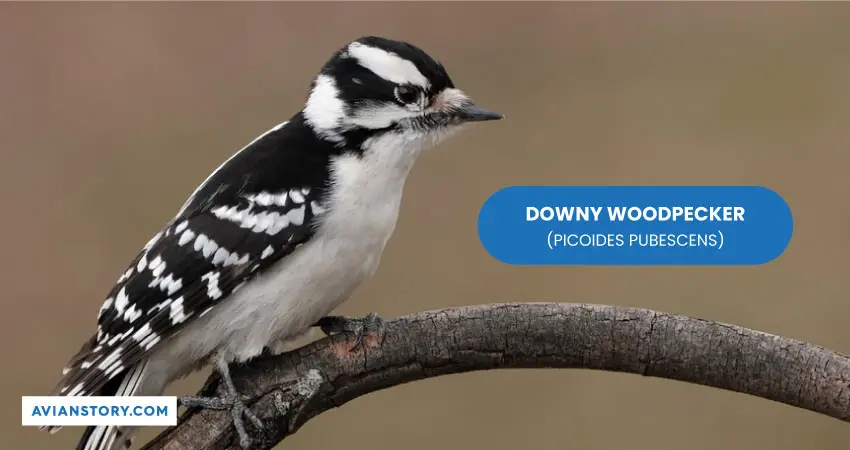
- Length: 5.6-6.9 in
- Weight: 0.8-1.2 ounces
- Wingspan: 10.1-12.6 in
- Commonly Found in: Mature forests
A tiny cute bird singing the sweetest of songs with a black body having silver patches. Well, it would have to be the Downy if the belly is silver. The bird has a brown patch on the head to identify it more accurately. Moreover, you will find its beak extremely small and the tails short.
Downy loves to eat larvae, insects, and berries. If it spots a feeder, it also doesn’t shy of stealing the hummingbird’s drink.
And the little bird hangs around throughout the year. Even in the winter, it’s too lazy to migrate for warmer habitats. If you want to attract it to the feeder, be sure to prepare seeds and peanuts for the guest.
2. Lewis’s Woodpecker

- Length: 10.5-11.1 in
- Weight: 3.3-5.1 ounces
- Wingspan: 20.0- 21.0 in
- Commonly Found in: Pine Forests
This is the most easily identified bird among woodpeckers. The greenish-black wings, pink belly, deep red mouth, and long-pointed beak will let you know that it’s Lewis’s woodpecker. You will see them throughout the year, especially in the fall.
What’s unique is its manner of hunting the prey. It snatches the insects in mid-air. Moreover, it loves to dine with berries and acorns, among other foods. This medium-sized bird is a treat to watch when it wanders around your backyard.
3. Hairy Woodpecker

- Length: 7.0-10.5 in
- Weight: 1.2-3.6 ounces
- Wingspan: 12.6-13.0 in
- Commonly Found in: Burnt forests
Here’s a bird that resembles the Downy from its face to its tail. Yes, I left the beak, for that’s where the difference lies. See, when you compare the pictures of the two, the first thing you’ll notice is the longer beak of the Hairy. Apart from that, there’s the same black and silver combination.
This bird has a shy nature. Therefore, it’s a bit more difficult to attract it to your backyard. But when you do, make sure that corn, peanuts, insects, or larvae are the items on the dish. This bird is also non-migratory, like many other woodpecker species.
4. American Three-toed Woodpecker
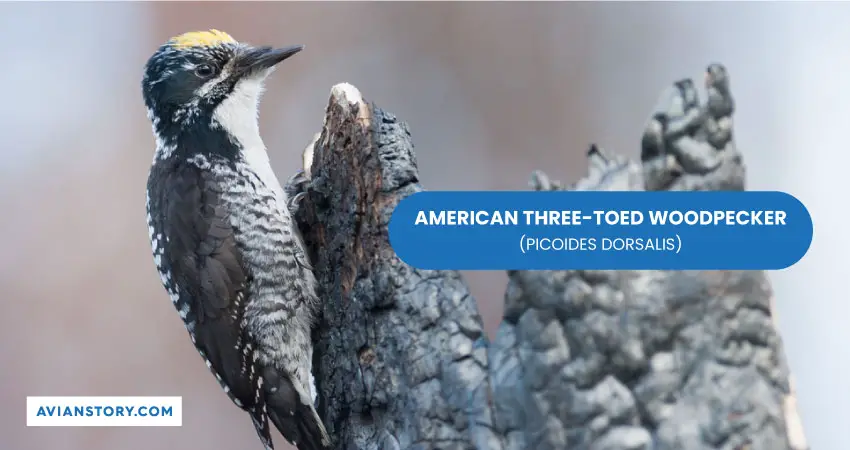
- Length: 8.4-9.2 in
- Weight: 1.8-2.5 ounces
- Wingspan: 15.1-16.2 in
- Commonly Found in: Coniferous forests
Have you ever heard of a woodpecker drinking sap? Well, the species finds the sap tasty, along with fruits, berries, and larvae. It’s unlikely to spot one of these birds in the bird feeders, though. They are comfortable in coniferous forests rather than residential areas.
The bird is gorgeous, with a greyish belly, black and white body, and a stout beak. And the males sport a yellow crown. Also, at its sides, it has white dots on the black wings.
5. Northern Flicker
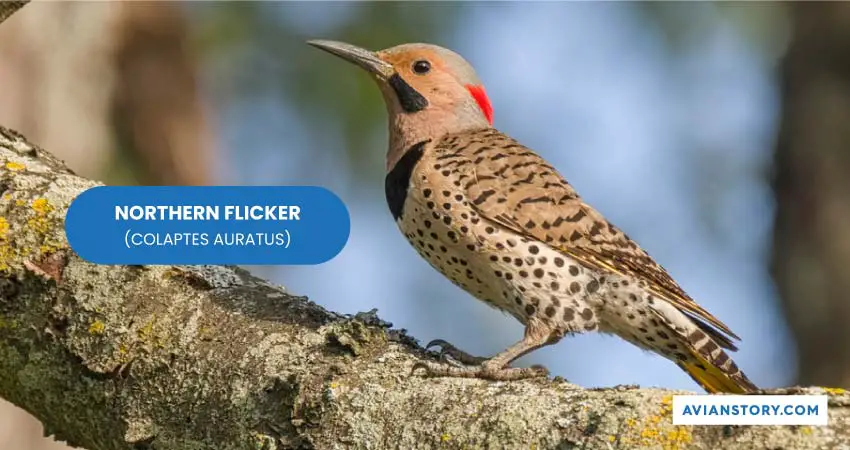
- Length: 10.9-13 in
- Weight: 3.9-6.1 ounces
- Wingspan: 17.1-20.0 in
- Commonly Found in: Old Forests
‘The ground feeders’ – that’s how they are known in the woodpeckers’ world. Yes, these birds get along with the residential areas fine, for there are plenty of fields to dine on. The bird does love the seeds, insects, larvae, corn, and berries a lot too.
You will have to appreciate the creamy body these birds sport. And the black rounded marking makes them stand out among the crowd of woodpeckers. The pink patch below the bill is also cute. Moreover, they produce a characteristic drumming tune to communicate.
6. Yellow-bellied Sapsucker

- Length: 7.7-8.2 in
- Weight: 1.4-2.3 ounces
- Wingspan: 13.2-15.7 in
- Commonly Found in: Sap-producing Forests
Here’s a shy-natured bird that likes to reside in the forests. It has a vibrant red patch on the head. And if it’s a female, there will be a white patch on the throat, whereas the males sport a red one. The body shows black, white, and brownish colors.
This is a winter-time bird in the locality. They visit Nebraska during the non-breeding time of the year. Other than sap, they like to eat insects. However, it’s less likely to find them near the suet feeders.
7. Williamson’s Sapsucker
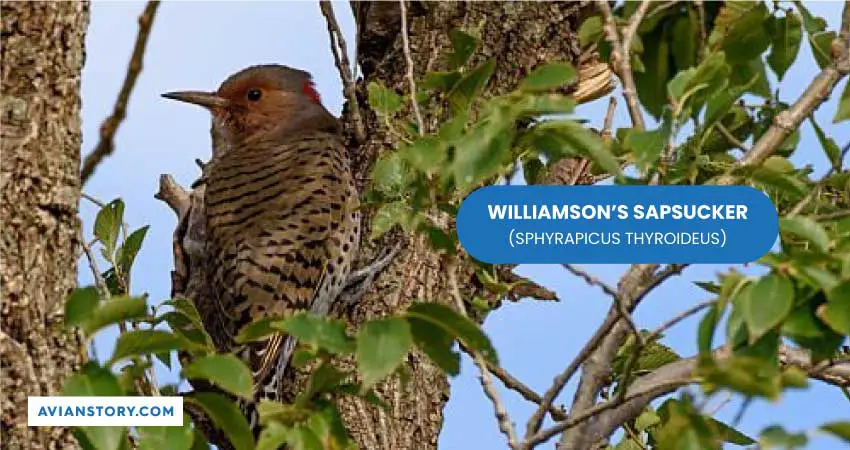
- Length: 8.5-9.9 in
- Weight: 1.8-2.2 ounces
- Wingspan: 16.5-17.3 in
- Commonly Found in: Mountainous forests
You should try to spot this bird at the earliest since it’s dangerously decreasing in numbers. The bird puts up quite a show when it’s breeding. It would also be fun to listen to the particular calling it has. And like most woodpeckers, it’s fond of coniferous forests.
You will identify the bird by the solid black back and the faint yellow belly. And if it’s a male, the throat would contain a red patch, whereas it’s a yellow one on the females. There’s a white shade on the sides and a grey one near the belly.
This bird has this long tongue to drink the sap. And it doesn’t refuse berries, corn, and nuts, either.
8. Red-bellied Woodpecker

- Length: 9-11 in
- Weight: 1.8-3.4 ounces
- Wingspan: 12-17 in
- Commonly Found in: Oak Forests
Now we are talking about a commonly seen bird. You might find a woodpecker shooing away other birds from the feeder. If it sports a vibrant red on the head, it might be the Red-bellied woodpecker. The throat is whitish creamy, whereas its chest and belly are yellowish.
The amazingly long tongue of this woodpecker will make you wonder – where does it accommodate the tongue? Well, it is twisted inside to make space. The black and white stripes on the back are also lovely to watch. Besides, by being highly attracted to bird feeders, it will visit the backyard frequently.
9. Red-headed Woodpecker
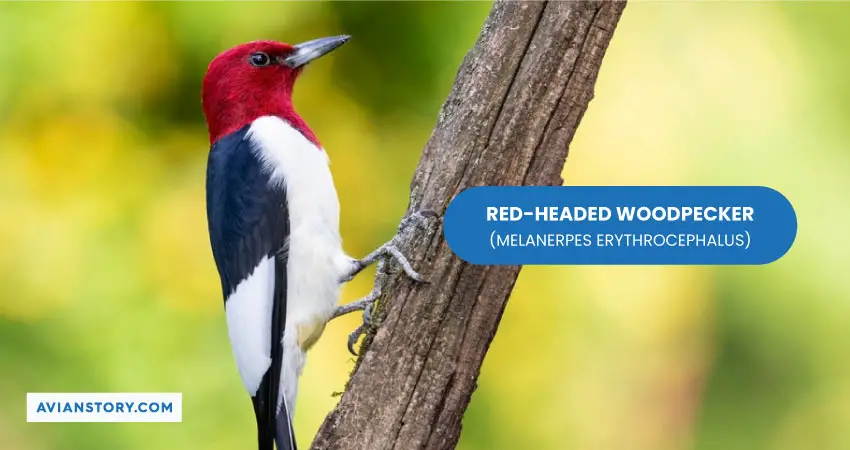
- Length: 7.7-9.9 in
- Weight: 2.2-3.6 ounces
- Wingspan: 16.1-16.9 in
- Commonly Found in: Pine Forests
As the name suggests, this bird sports the deepest red all over its head. And the belly is white as the moon. On the back, there’s a combination of black and white. They usually fly around in big flocks. If you have tasty nuts and seeds prepared in the feeder, they will be delighted to visit you.
They also like to feed on larvae and insects. However, their favorite food is the acorn. That’s why you will find them in numbers near grassy areas. Moreover, they take the oak forests as their homes.
10. Pileated Woodpecker
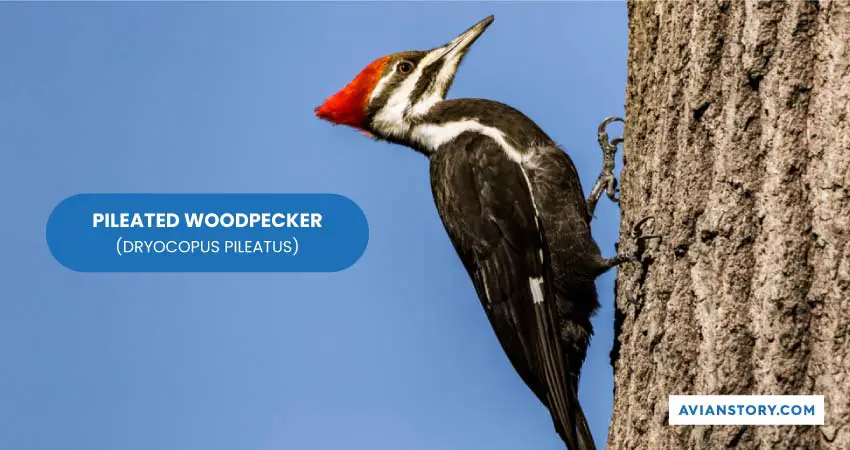
- Length: 18-20 in
- Weight: 10-15 ounces
- Wingspan: 31-33 in
- Commonly Found in: high-elevation forests
Now we are talking about a relatively large woodpecker. These guys do not visit the backyard often. However, it’s not due to the uniqueness of their food habit. The bird does share a similar taste to that of its cousins. Nevertheless, the population has declined to a noticeably low level in Nebraska.
The red crown on its head is easy to detect from far. The rest of the body is mainly black, with a few white patches here and there. During winter, they like to move toward the forests near rivers. The males with the red mustaches call out to the females for breeding in an interesting manner.
11. Acorn Woodpecker
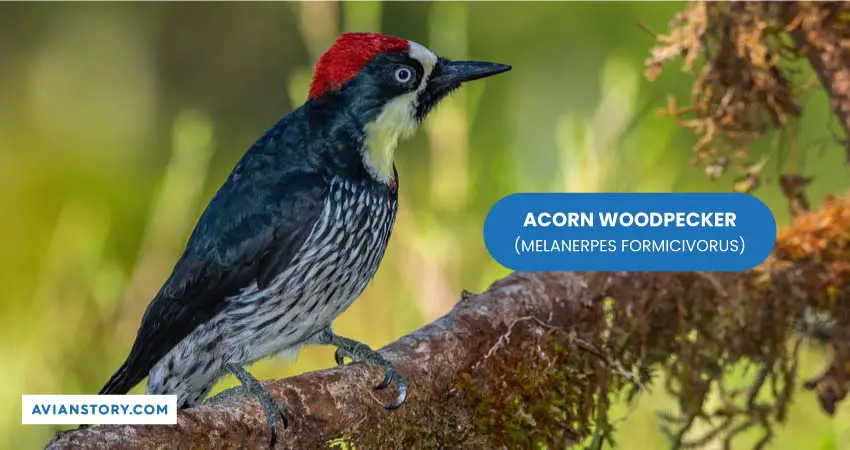
- Length: 7.6-9.2 in
- Weight: 2.5-3.3 ounces
- Wingspan: 13.6-17.2 in
- Commonly Found in: Oak Forests
Acorn has something special about it – the storage of acorns in the trees. So, here’s a woodpecker that has a unique habit. However, they also feed on insects, eat those yummy nuts, and forage larvae like others. If you want to spot a bunch of them, go to an oak forest first.
The black stripes on the white belly make this bird distinguishable. And the red patch on the back of the head creates a somewhat glamorous image. The beak of the males is larger. And the feathers are white on the females. You can attract this bird to the feeder also.
12. Red-cockaded Woodpecker
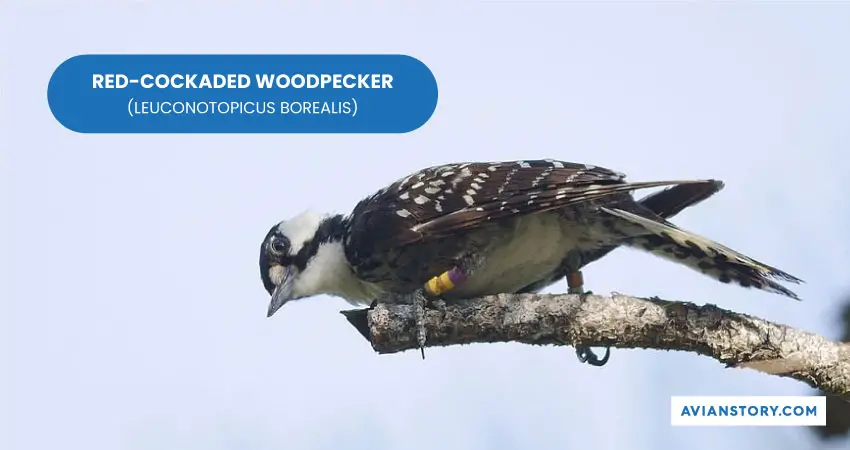
- Length: 7.6-9.3 in
- Weight: 1.5-2.1 ounces
- Wingspan: 13.6-17.4 in
- Commonly Found in: Pine Forests
Here’s another bird that might not hang around for long. If you want access to this beautiful woodpecker, you will have to visit the pine forests. It’s also worth mentioning that there’s no point in anticipating them at the backyard feeders.
The bird has no red, contrary to the name. However, a magnified image taken up close may reveal a red streak on the male’s cheek. The rest of the body looks similar to that of its cousins – white stripes on a black body. On the neck and cheek, there’s a white patch. And the belly is white.
13. Black-backed Woodpecker
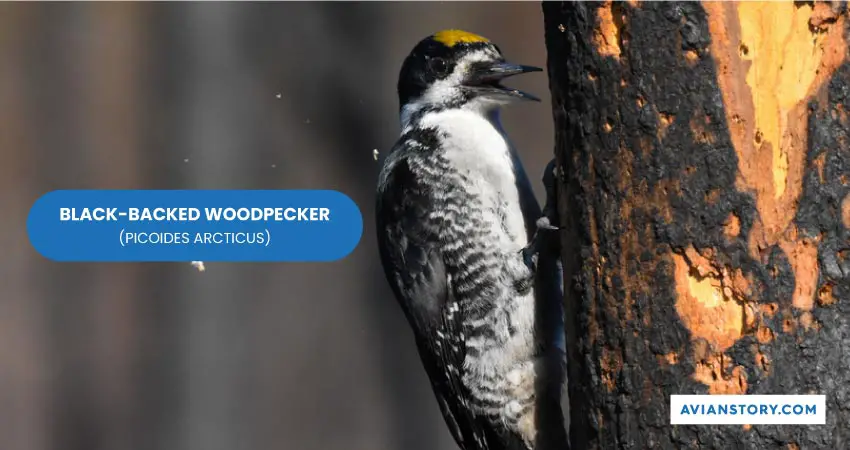
- Length: 9-9.5 in
- Weight: 2-3 ounces
- Wingspan: 14.8-16.3 in
- Commonly Found in: Burnt Forests
The rhythmic drumming of the birds will notify you that a woodpecker is nearby. Now, if it’s summertime, and the bird has a solid black back, you can guess that it’s a Black-backed woodpecker. The species also sports a white belly with a yellow patch on the crown.
The food of this bird is, as usual – insects, larvae, nuts, and suet. Yes, once you set up a suet feeder with seeds, expect a meeting with this sweet bird. Now, when there are not enough regular foods, they will gladly live off fruits and berries.
14. Red-naped Sapsucker
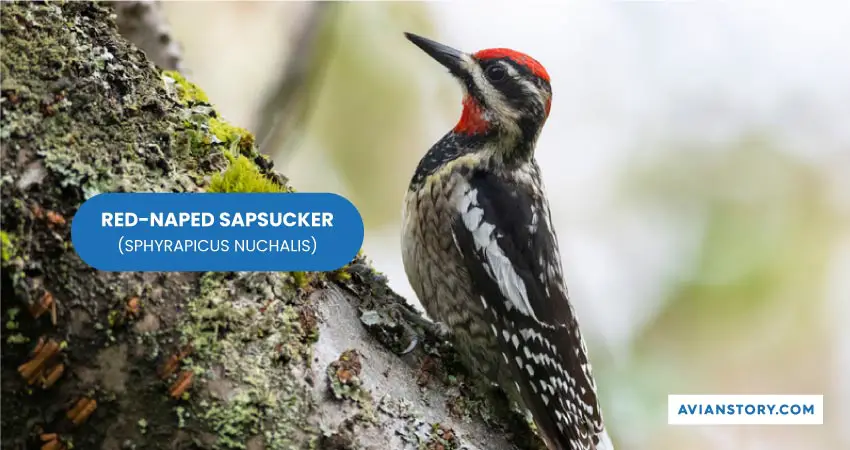
- Length: 7.8-8.2 in
- Weight: 1.4-2.5 ounces
- Wingspan: 16.3-17.0 in
- Commonly Found in: Mid-elevation forests
You are driving on a busy road somewhere in Nebraska and suddenly spot a bird with a red nape. And it looks like drinking something nutritious from the roadside tree. Now, make no mistake that it’s one of the sapsuckers. The Red-naped one visits the locality mostly around May to June.
These birds build nests by excavating the old trees. When they do, the females will lay about half a dozen eggs. These eggs need incubation for half a month. And the babies need about a month to be able to hang out with their parents. Among other foods, they love insects and berries.
Final Words
Words of dream-coming-true-events have been spoken. Tales have been written. Now it’s your turn to join the caravan by writing your own’ woodpeckers in Nebraska stories’. It would be a pleasure if you shared your thrilling birding experiences with us.
Woodpeckers Found in Some Other States:
